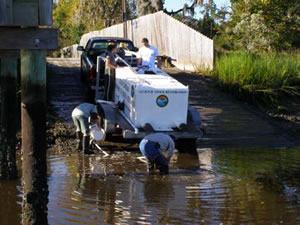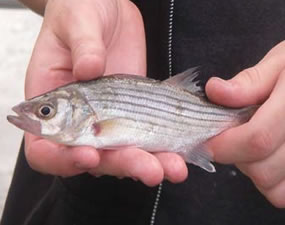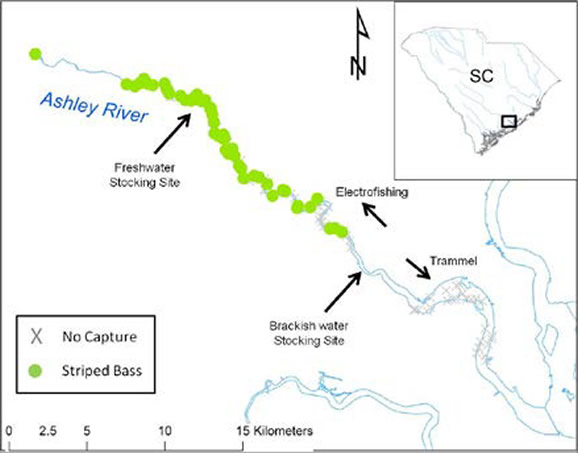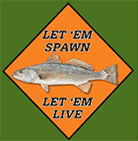Restoring a Striped Bass Population in the Ashley River
Striped bass, Morone saxatilis, is a long-lived species that inhabit coastal estuaries and rivers along the east coast of North America from the St. Lawrence River in Canada to the St. John’s River in Florida and extending into the Gulf of Mexico. Striped bass populations throughout their native range have been suffering population declines during the past decade, and most hypotheses associate these declines with increased summer water temperatures. The Ashley River, a small, tidally-influenced river that drains into Charleston Harbor, has historically supported a striped bass population and a recreational fishery. However, very few adult fish and no juveniles had been observed in the Ashley River since SCDNR began routine monthly sampling in the early 1990s. The state of South Carolina pioneered many techniques for spawning and producing striped bass, and widespread stocking of freshwater systems with fingerlings from the Santee-Cooper river system has been conducted in South Carolina since the early 1960s. While much of the stocking program has focused on freshwater systems, our research team has been evaluating the potential for re-establishing a self-sustaining striped bass population in the Ashley River. In recent years, the state of South Carolina has set goals to re-establish historic biodiversity levels, and restoring a key indicator species like striped bass is an important step toward meeting this conservation goal. Our project was designed to build a restoration model for striped bass by improving our understanding of their life history, habitat usage and population dynamics in coastal rivers along the southeast US Atlantic coast. The project utilized hatchery-produced fish and state-of-the-art genetic tools to address these challenging biological and ecological questions.

By stocking genetically-identifiable small (~3 inch) and large (~6-9 inch) juvenile striped bass in the Ashley River (fig. 1) and evaluating their survival and contribution through regular sampling, we have determined that fish spawned in spring and stocked at ~3 (fig. 2) inches during May exhibit poor survival through their first summer – potentially suggesting a temperature tolerance limitation. However, our laboratory experiments, using hatchery-produced striped bass, indicated that summer temperature and salinity experienced in the Ashley River alone are not lethal to juvenile fish. Therefore, it is likely that interactions with additional factors, such as food availability, predation, and oxygen availability are contributing to poor juvenile summer survival. Field-based data on habitat utilization support this idea based on the occurrence of striped bass throughout the upper portions of the system in low salinity, lower temperature and highly structured habitats. Furthermore, larger ~6-9 inch fish (fig. 3) stocked in the fall of their first year show higher survival and contribution to the striped bass population, suggesting a definite advantage to larger fish, or later stocking which bypasses their first summer in the wild.


A critical aspect of any restoration work is determination of the sustainability of the population. Following the first three years of experimental-scale stocking in the Ashley River, we documented the presence of non-stocked juvenile striped bass in the system for the first time in over a decade, likely representing natural reproduction and recruitment within the system. The documentation of non-stocked juvenile recruitment has continued now for three successive years. Therefore, it does appear that adequate habitat and resources are available for some long-term survival and natural reproduction of the striped bass in the Ashley River. Additionally, we have documented recaptured striped bass remaining in the Ashley River from year-to-year, which indicates annual survival and retention of fish in the system (fig. 4).

By successfully implementing our comprehensive experimental restoration project, we have identified the most effective stocking strategy for re-establishing a striped bass population in the Ashley River and determined some of the limitations to survival of young fish within the system. We have detected the occurrence of natural reproduction in the Ashley River, which is an essential element of a healthy, self-sustaining population. Based on the data collected from this project, we are building a restoration plan to re-establish a population of striped bass in the river that is similar in genetic diversity to a natural striped bass population in the Santee-Cooper drainage system. The restoration plan will identify the number of stocked fish needed to successfully restore a population of striped bass to a coastal system as well as the number of broodstock parents needed to maintain a high degree of diversity and a healthy genetic structure. The results of our project will be a valuable management tool by serving as a model for striped bass restoration efforts in other coastal systems throughout the southeastern US. As it has for over fifty years, SCDNR is leading the way in striped bass management, restoration, and stock enhancement research.



